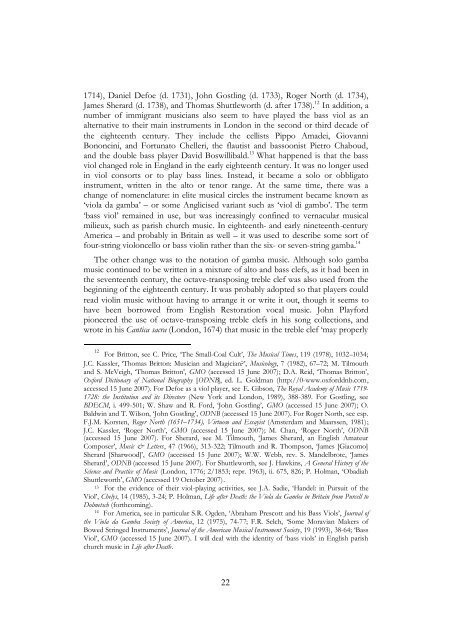download PDF (4.2 MB) - Viola da Gamba Society
download PDF (4.2 MB) - Viola da Gamba Society
download PDF (4.2 MB) - Viola da Gamba Society
You also want an ePaper? Increase the reach of your titles
YUMPU automatically turns print PDFs into web optimized ePapers that Google loves.
1714), Daniel Defoe (d. 1731), John Gostling (d. 1733), Roger North (d. 1734),<br />
James Sherard (d. 1738), and Thomas Shuttleworth (d. after 1738). 12 In addition, a<br />
number of immigrant musicians also seem to have played the bass viol as an<br />
alternative to their main instruments in London in the second or third decade of<br />
the eighteenth century. They include the cellists Pippo Amadei, Giovanni<br />
Bononcini, and Fortunato Chelleri, the flautist and bassoonist Pietro Chaboud,<br />
and the double bass player David Boswillibald. 13 What happened is that the bass<br />
viol changed role in England in the early eighteenth century. It was no longer used<br />
in viol consorts or to play bass lines. Instead, it became a solo or obbligato<br />
instrument, written in the alto or tenor range. At the same time, there was a<br />
change of nomenclature: in elite musical circles the instrument became known as<br />
‘viola <strong>da</strong> gamba’ – or some Anglicised variant such as ‘viol di gambo’. The term<br />
‘bass viol’ remained in use, but was increasingly confined to vernacular musical<br />
milieux, such as parish church music. In eighteenth- and early nineteenth-century<br />
America – and probably in Britain as well – it was used to describe some sort of<br />
four-string violoncello or bass violin rather than the six- or seven-string gamba. 14<br />
The other change was to the notation of gamba music. Although solo gamba<br />
music continued to be written in a mixture of alto and bass clefs, as it had been in<br />
the seventeenth century, the octave-transposing treble clef was also used from the<br />
beginning of the eighteenth century. It was probably adopted so that players could<br />
read violin music without having to arrange it or write it out, though it seems to<br />
have been borrowed from English Restoration vocal music. John Playford<br />
pioneered the use of octave-transposing treble clefs in his song collections, and<br />
wrote in his Cantica sacra (London, 1674) that music in the treble clef ‘may properly<br />
12 For Britton, see C. Price, ‘The Small-Coal Cult’, The Musical Times, 119 (1978), 1032–1034;<br />
J.C. Kassler, ‘Thomas Britton: Musician and Magician?’, Musicology, 7 (1982), 67–72; M. Tilmouth<br />
and S. McVeigh, ‘Thomas Britton’, GMO (accessed 15 June 2007); D.A. Reid, ‘Thomas Britton’,<br />
Oxford Dictionary of National Biography [ODNB], ed. L. Goldman (http://0-www.oxforddnb.com,<br />
accessed 15 June 2007). For Defoe as a viol player, see E. Gibson, The Royal Academy of Music 1719-<br />
1728: the Institution and its Directors (New York and London, 1989), 388-389. For Gostling, see<br />
BDECM, i. 499-501; W. Shaw and R. Ford, ‘John Gostling’, GMO (accessed 15 June 2007); O.<br />
Baldwin and T. Wilson, ‘John Gostling’, ODNB (accessed 15 June 2007). For Roger North, see esp.<br />
F.J.M. Korsten, Roger North (1651–1734), Virtuoso and Essayist (Amster<strong>da</strong>m and Maarssen, 1981);<br />
J.C. Kassler, ‘Roger North’, GMO (accessed 15 June 2007); M. Chan, ‘Roger North’, ODNB<br />
(accessed 15 June 2007). For Sherard, see M. Tilmouth, ‘James Sherard, an English Amateur<br />
Composer’, Music & Letters, 47 (1966), 313-322; Tilmouth and R. Thompson, ‘James [Giacomo]<br />
Sherard [Sharwood]’, GMO (accessed 15 June 2007); W.W. Webb, rev. S. Mandelbrote, ‘James<br />
Sherard’, ODNB (accessed 15 June 2007). For Shuttleworth, see J. Hawkins, A General History of the<br />
Science and Practice of Music (London, 1776; 2/1853; repr. 1963), ii. 675, 826; P. Holman, ‘Obadiah<br />
Shuttleworth’, GMO (accessed 19 October 2007).<br />
13 For the evidence of their viol-playing activities, see J.A. Sadie, ‘Handel: in Pursuit of the<br />
Viol’, Chelys, 14 (1985), 3-24; P. Holman, Life after Death: the <strong>Viola</strong> <strong>da</strong> <strong>Gamba</strong> in Britain from Purcell to<br />
Dolmetsch (forthcoming).<br />
14 For America, see in particular S.R. Ogden, ‘Abraham Prescott and his Bass Viols’, Journal of<br />
the <strong>Viola</strong> <strong>da</strong> <strong>Gamba</strong> <strong>Society</strong> of America, 12 (1975), 74-77; F.R. Selch, ‘Some Moravian Makers of<br />
Bowed Stringed Instruments’, Journal of the American Musical Instrument <strong>Society</strong>, 19 (1993), 38-64; ‘Bass<br />
Viol’, GMO (accessed 15 June 2007). I will deal with the identity of ‘bass viols’ in English parish<br />
church music in Life after Death.<br />
22

















